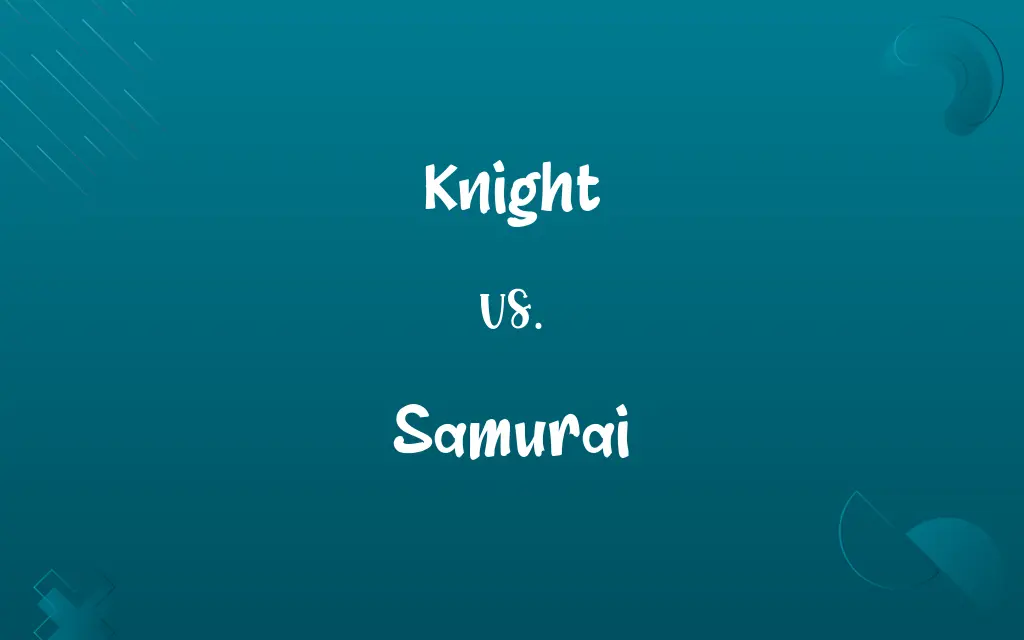Knight vs. Samurai: Know the Difference

By Shumaila Saeed || Updated on December 25, 2023
Knights were medieval European warriors serving a lord, bound by chivalry; Samurai were Japanese warriors serving a daimyo, following Bushido code.

Key Differences
Knights were warriors in medieval Europe, typically serving a liege lord or monarch. They were bound by the code of chivalry, emphasizing bravery, honor, and gallantry towards women. For example, a knight would serve his king loyally in battle. Samurai were members of a powerful military caste in feudal Japan, serving a daimyo (feudal lord). They followed the Bushido code, which stressed loyalty, martial arts mastery, and honor unto death, such as a samurai serving his daimyo faithfully.
Shumaila Saeed
Nov 17, 2023
The social status of knights varied, with some being of noble birth, while others were commoners who earned knighthood through valor. A knight could rise in status through acts of bravery. Samurai, however, were always part of the Japanese social elite, hereditary warriors with a high social status from birth, as shown by a samurai's inherited position.
Shumaila Saeed
Nov 17, 2023
Knights were heavily armored, especially in the later Middle Ages, and fought primarily on horseback. They were known for their use of swords, lances, and shields, like a knight charging into battle with his lance. Samurai, in contrast, were known for their skill with the katana and bow, and although they also fought on horseback, their armor was more flexible to allow swift movement, reflecting a samurai's agility in combat.
Shumaila Saeed
Nov 17, 2023
The knight’s role evolved over time, from a warrior class to a more symbolic and ceremonial role by the Renaissance, as seen in the ceremonial duties of a knight. The samurai, on the other hand, retained a significant political and military role in Japan until the Meiji Restoration, with a samurai's role adapting to the changing political landscape.
Shumaila Saeed
Nov 17, 2023
The cultural impact of knights and samurai extends into modern times, with knights often symbolizing the ideals of chivalry and heroism in Western culture, while samurai are admired for their discipline, skill, and loyalty in Japanese culture and beyond, as portrayed in various forms of art and literature.
Shumaila Saeed
Nov 17, 2023
ADVERTISEMENT
Comparison Chart
Code of Conduct
Chivalry (bravery, honor, courtesy)
Bushido (loyalty, honor, martial arts mastery)
Shumaila Saeed
Nov 17, 2023
Social Status
Varied, could be noble or commoner
Hereditary, elite social class
Shumaila Saeed
Nov 17, 2023
Role Evolution
Evolved to ceremonial role
Maintained military, political role
Shumaila Saeed
Nov 17, 2023
ADVERTISEMENT
Knight and Samurai Definitions
Knight
A medieval warrior of European origin, often of noble status.
The knight swore allegiance to his king.
Shumaila Saeed
Nov 16, 2023
Samurai
A skilled, disciplined warrior, often idealized in Japanese culture.
The samurai was renowned for his mastery of the katana.
Shumaila Saeed
Nov 16, 2023
Knight
A person devoted to the service of a woman as a chivalrous lover.
In the tale, he acted as a knight to the distressed damsel.
Shumaila Saeed
Nov 16, 2023
Samurai
A person embodying the qualities of discipline, honor, and skill, like historical samurai.
In business, he was as disciplined as a samurai.
Shumaila Saeed
Nov 16, 2023
Knight
A medieval tenant giving military service as a mounted man-at-arms to a feudal landholder.
Shumaila Saeed
Oct 19, 2023
ADVERTISEMENT
Samurai
A member of the Japanese warrior caste, historically serving feudal lords.
The samurai served his daimyo with utmost loyalty.
Shumaila Saeed
Nov 16, 2023
Knight
A medieval gentleman-soldier, usually high-born, raised by a sovereign to privileged military status after training as a page and squire.
Shumaila Saeed
Oct 19, 2023
Samurai
A figure in Japanese history and folklore, often romanticized.
Legends spoke of the samurai's bravery and honor.
Shumaila Saeed
Nov 16, 2023
Knight
A man holding a nonhereditary title conferred by a sovereign in recognition of personal merit or service to the country.
Shumaila Saeed
Oct 19, 2023
Samurai
In the former feudal system of Japan, the class or a member of the class, of military retainers of the daimios, constituting the gentry or lesser nobility. They possessed power of life and death over the commoners, and wore two swords as their distinguishing mark. Their special rights and privileges were abolished with the fall of feudalism in 1871. They were referred to as "a cross between a knight and a gentleman".
Shumaila Saeed
Oct 19, 2023
Knight
Abbr. Kt or N(Games) A chess piece, usually in the shape of a horse's head, that can be moved two squares along a rank and one along a file or two squares along a file and one along a rank. The knight is the only piece that can jump other pieces to land on an open square.
Shumaila Saeed
Oct 19, 2023
Samurai
A Japanese warrior who was a member of the feudal military aristocracy
Shumaila Saeed
Oct 19, 2023
Knight
(historical) A young servant or follower; a trained military attendant in service of a lord.
Shumaila Saeed
Oct 19, 2023
Samurai
In modern usage, someone who is fiercely loyal or devoted to a cause.
She was a samurai in her dedication to environmental protection.
Shumaila Saeed
Nov 16, 2023
Knight
(historical) A minor nobleman with an honourable military rank who had served as a page and squire.
Shumaila Saeed
Oct 19, 2023
Knight
(by extension) An armored and mounted warrior of the Middle Ages.
King Arthur and the Knights of the Round Table
Shumaila Saeed
Oct 19, 2023
Knight
A person obliged to provide knight service in exchange for maintenance of an estate held in knight's fee.
Shumaila Saeed
Oct 19, 2023
Knight
(modern) A person on whom a knighthood has been conferred by a monarch.
Shumaila Saeed
Oct 19, 2023
Knight
(literary) A brave, chivalrous and honorable man devoted to a noble cause or love interest.
Shumaila Saeed
Oct 19, 2023
Knight
(chess) A chess piece, often in the shape of a horse's head, that is moved two squares in one direction and one at right angles to that direction in a single move, leaping over any intervening pieces.
Shumaila Saeed
Oct 19, 2023
Knight
(entomology) Any of various nymphalid butterflies of the genus Ypthima.
Shumaila Saeed
Oct 19, 2023
Knight
(transitive) To confer knighthood upon.
The king knighted the young squire.
Shumaila Saeed
Oct 19, 2023
Knight
In feudal times, a man-at-arms serving on horseback and admitted to a certain military rank with special ceremonies, including an oath to protect the distressed, maintain the right, and live a stainless life.
Knights, by their oaths, should right poor ladies' harms.
Shumaila Saeed
Oct 19, 2023
Knight
To dub or create (one) a knight; - done in England by the sovereign only, who taps the kneeling candidate with a sword, saying: Rise, Sir --.
A soldier, by the honor-giving handOf CŒur-de-Lion knighted in the field.
Shumaila Saeed
Oct 19, 2023
Knight
Originally a person of noble birth trained to arms and chivalry; today in Great Britain a person honored by the sovereign for personal merit
Shumaila Saeed
Oct 19, 2023
Knight
A chessman in the shape of a horse's head; can move two squares horizontally and one vertically (or vice versa)
Shumaila Saeed
Oct 19, 2023
Knight
A titled honor granted for bravery or service, especially in the UK.
He was made a knight for his contributions to science.
Shumaila Saeed
Nov 16, 2023
Knight
A chess piece, moving in an L-shape.
She moved her knight to protect the king.
Shumaila Saeed
Nov 16, 2023
Knight
A person regarded as having qualities associated with medieval knights, like bravery.
He was celebrated as a knight for his heroic deeds.
Shumaila Saeed
Nov 16, 2023
Repeatedly Asked Queries
Did knights wear armor?
Yes, knights typically wore metal armor for protection during battles and tournaments.
Shumaila Saeed
Nov 17, 2023
When did knights exist?
Knights were most prominent during the medieval period in Europe, roughly from the 10th to the 15th centuries.
Shumaila Saeed
Nov 17, 2023
What is a samurai?
A samurai was a member of the Japanese warrior class, a skilled fighter who served a feudal lord and followed a strict ethical code known as Bushido.
Shumaila Saeed
Nov 17, 2023
Were knights part of a social class?
Yes, knights were part of a distinct social class in medieval Europe, often coming from nobility or the warrior class.
Shumaila Saeed
Nov 17, 2023
What is a knight?
A knight is a person granted an honorary title of knighthood by a monarch or other political leader for service to the monarch or country, especially in a military capacity.
Shumaila Saeed
Nov 17, 2023
What era did samurais belong to?
Samurai were significant in Japan from the 12th to the 19th centuries, especially during the feudal era.
Shumaila Saeed
Nov 17, 2023
Was being a samurai hereditary?
Yes, becoming a samurai was typically hereditary, and families passed down their status and privileges through generations.
Shumaila Saeed
Nov 17, 2023
What weapons did knights use?
Knights commonly used swords, lances, and shields, along with various other medieval weapons.
Shumaila Saeed
Nov 17, 2023
What is chivalry?
Chivalry is the traditional code of conduct associated with medieval knighthood, emphasizing virtues like bravery, courtesy, honor, and gallantry towards women.
Shumaila Saeed
Nov 17, 2023
Can women be knights?
Historically, knighthood was male-dominated, but in modern times, women can be granted honorary knighthoods.
Shumaila Saeed
Nov 17, 2023
Were there female samurais?
While rare, there were female samurais known as "Onna-Bugeisha," who engaged in battle alongside male samurais.
Shumaila Saeed
Nov 17, 2023
Did samurais use horses?
Yes, samurais were skilled horsemen and often used horses in battles and during the feudal era.
Shumaila Saeed
Nov 17, 2023
What is Bushido?
Bushido is the code of moral principles that the samurai were required to observe; it emphasized loyalty, martial arts mastery, and honor unto death.
Shumaila Saeed
Nov 17, 2023
What is the Round Table?
The Round Table refers to King Arthur's legendary table in Arthurian legend, at which he and his knights congregated.
Shumaila Saeed
Nov 17, 2023
What kind of armor did samurais wear?
Samurais wore armor made of leather and metal, including helmets and masks, designed for both protection and mobility.
Shumaila Saeed
Nov 17, 2023
What were the primary weapons of a samurai?
Samurai were renowned for their skill with the katana (a long sword) and the wakizashi (a shorter sword), as well as the bow and arrow.
Shumaila Saeed
Nov 17, 2023
What is a knight's mount?
Knights typically rode horses, which were trained for battle and often wore protective armor.
Shumaila Saeed
Nov 17, 2023
Are knights still appointed today?
Yes, but modern knighthood is a symbolic title recognizing contributions to society or the state and does not involve military service.
Shumaila Saeed
Nov 17, 2023
What is a "Ronin"?
A Ronin was a samurai without a master during the feudal period of Japan, often due to the loss or fall of their lord.
Shumaila Saeed
Nov 17, 2023
Is the samurai class still active?
No, the samurai class ceased to exist as a distinct social class with the Meiji Restoration in the late 19th century.
Shumaila Saeed
Nov 17, 2023
Share this page
Link for your blog / website
HTML
Link to share via messenger
About Author
Written by
Shumaila SaeedShumaila Saeed, an expert content creator with 6 years of experience, specializes in distilling complex topics into easily digestible comparisons, shining a light on the nuances that both inform and educate readers with clarity and accuracy.









































































